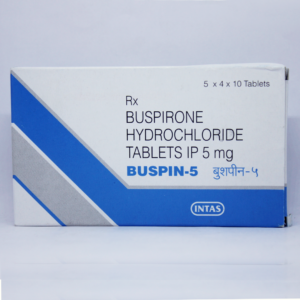Xepar
XEPAR is an antidepressant drug that is used to treat major depression, obsessive-compulsive disorder (OCD), panic disorder, social anxiety disorder, post-traumatic stress disorder, premenstrual dysphoria disorder, and generalized anxiety disorder. A mood condition characterized by sadness, dissatisfaction, anger, hopelessness, or loss that interferes with a person’s daily activities is known as depression.
XEPAR contains the selective serotonin reuptake inhibitor ‘Paroxetine.’ It works by preventing serotonin reuptake in the brain, which is a mood-enhancing chemical messenger that talks between brain cells. This helps regulate mood and cure depression and anxiety disorders by increasing serotonin concentrations in the neuronal synapse.
Take XEPAR exactly as directed. Depending on your medical condition and response to treatment, you should take XEPAR for as long as your doctor has prescribed it. Certain typical side effects may occur, including insomnia (difficulty sleeping), dizziness, headache, diarrhea, nausea, exhaustion, dry mouth, loss of appetite, pin and sexual problems. If you are experiencing these adverse effects on a regular basis, you should consult your doctor.
If you are pregnant, avoid taking XEPAR since it may harm the fetus. If you are breastfeeding, talk to your doctor before taking XEPAR. XEPAR can induce dizziness, disorientation, tiredness, and impaired vision, so don’t drive or operate machinery while taking it. XEPAR is not suggested for children under the age of 18 because its safety and effectiveness have yet to be determined. Avoid drinking alcohol while taking XEPAR because it may exacerbate your symptoms or adverse effects. To rule out any negative effects, keep your doctor updated about your health condition and medications.

Xepar’s Applications
OCD, panic disorder, social anxiety disorder, post-traumatic stress disorder, premenstrual dysphoric disorder, and generalized anxiety disorder are all examples of major depressive disorders.
Medicinal Advantages
XEPAR is a selective serotonin reuptake inhibitor, which is a type of antidepressant medication. Major depressive disorder, obsessive-compulsive disorder (OCD), panic disorder, social anxiety disorder, post-traumatic stress disorder, premenstrual dysphoric disorder, and generalized anxiety disorder are all treated with XEPAR. XEPAR works by preventing serotonin, a mood-enhancing chemical messenger in the brain that communicates between brain cells, from being reabsorbed by nerves. This helps regulate mood and cure depression and anxiety disorders by increasing serotonin concentrations in the neuronal synapse. XEPAR helps people recover from depression and has less negative side effects than earlier antidepressants.
Use Instructions
To avoid stomach discomfort, take XEPAR first thing in the morning with meals. Based on your medical condition and reaction to treatment, your doctor will determine how long you should take XEPAR. XEPAR should be taken exactly as directed by your doctor. XEPAR is available as a pill and as a liquid. Tablet: Take one XEPAR tablet with a glass of water and swallow whole; do not chew or crush the tablet. Liquid: Use the measuring cup provided in the package to take the indicated dose/quantity; shake the bottle well before use.
Storage
Store in a cool, dry location away from direct sunlight.
XEPAR Side Effects
I’m having trouble sleeping (difficulty sleeping)
Headache
Diarrhea
Nausea
Fatigue
Mouth is parched
Appetite loss.
Disturbances in sexual activity
Precautions and Warnings in Depth
If you are allergic to any of the ingredients in PEXEP, or if you are on or have recently taken monoamine oxidase inhibitors (MAOI), or if you are taking antipsychotic medications like thioridazine or pimozide, don’t take it. If you experience suicidal thoughts, such as murdering or injuring yourself, see your doctor right once. If you have/had epilepsy, mania, diabetes, low salt levels in the blood, glaucoma, or are receiving electro-convulsive therapy for severe depression, tell your doctor before using XEPAR. If you are pregnant, avoid taking XEPAR since it may harm the fetus. If you are breastfeeding, talk to your doctor before taking XEPAR. XEPAR can induce dizziness, disorientation, tiredness, and impaired vision, so don’t drive or operate machinery while taking it. XEPAR is not suggested for children under the age of 18 since its safety and effectiveness have not been proven. Avoid drinking alcohol while taking XEPAR because it may exacerbate your symptoms or adverse effects.
Interactions Between Drugs
Interactions between drugs: Blood thinners (warfarin, clopidogrel) and antipsychotics (perphenazine, thioridazine, clozapine) may interact with PAROXETINE. NSAIDs (acetylsalicylic acid, ibuprofen, celecoxib, etodolac, diclofenac, meloxicam, tramadol, pethidine), antidepressants (clomipramine, moclobemide, methylthioninium chloride/methylene blue, nortriptyline, desipramine), anti-cancer (tamoxifen), anti-migraine (sum (Procyclidine).
Drug-Food Interactions: Do not combine PAROXETINE with St. John’s wort (an herbal supplement used to treat depression). When taking PAROXETINE with alcohol, the sedative effects may be amplified.
PAROXETINE may interact with a variety of diseases, including glaucoma, diabetes, epilepsy, mania, bleeding issues, hyponatremia (low salt levels), heart, liver, and kidney malfunction.
Safety Suggestions
ALCOHOL
While using PAROXETINE, you should avoid drinking alcohol because it may exacerbate your symptoms or adverse effects.
PREGNANCY
PAROXETINE is classified as a pregnancy category D substance. If you are pregnant or planning to get pregnant, you should avoid taking PAROXETINE since it may harm the fetus.
BREAST FEEDING
PAROXETINE can be found in breast milk. Before using PAROXETINE, see your doctor; your doctor will determine whether or not PAROXETINE can be taken by breastfeeding moms.
DRIVING
Dizziness, disorientation, tiredness, and blurred vision are all possible side effects of PAROXETINE. If you have these symptoms, do not drive or use machinery.
LIVER
In patients with liver disease, dosage adjustments may be necessary. If you have any worries about this or if you have a liver problem, please visit your doctor.
KIDNEY
In patients with kidney disease, dose adjustments may be necessary. If you have any worries about this or if you have kidney impairment, please visit your doctor.
No habit formation
Advice on Diet and Lifestyle
Maintaining a nutritious diet and exercising on a regular basis can assist to improve general health and self-esteem.
Attend counseling sessions on a regular basis.
Practice yoga and meditation. This helps to relieve stress and calm the body.
To improve the amount and quality of sleep you obtain, stick to a regular sleep schedule.
Fish, nuts, fresh fruits and vegetables, and olive oils are all good sources of omega fatty acids.
Amino acids are the building blocks of neurotransmitters. Meat, dairy products, and certain fruits and vegetables are high in amino acids, which aid in the appropriate maintenance of neurotransmitters.
Serotonin is stimulated by complex carbs (a feel-good neurotransmitter). Whole grains, legumes, spinach, broccoli, oranges, and pears are among them.
Exercising aids in the creation of natural antidepressants in the body. It also aids in stress relief, mood enhancement, self-esteem enhancement, and comfortable sleep.
Avoid smoking and consuming alcoholic beverages.
Learn about your condition, recognize the risk factors, and stick to the treatment plan prescribed by your doctor.
Recommendations
Patients taking PAROXETINE for suicidal conduct should be closely monitored. If you’re thinking about hurting or killing yourself, see your doctor right away.
Additional Information: This item is non-refundable.
Glossary of Diseases and Conditions
Depressive illness (major depressive disorder): Clinical depression, also known as major depressive disorder, is a mental health condition defined by a continuous and severe experience of melancholy over a long period of time. Mood, behavior, and other physical systems such as sleep and appetite are all affected. Sadness, loss of interest, changes in food, sleep problems, restlessness, lack of energy, feelings of worthlessness or guilt, thoughts of self-harm, and difficulty concentrating, making decisions, and thinking are all symptoms. Depression’s specific cause is uncertain. However, stress, hormonal changes, alcohol or drug misuse, childhood maltreatment, certain medical disorders, and medications may all raise the chance of developing depression.
Obsessive-Compulsive Condition (OCD) is a mental disorder characterized by obsessive thinking (obsessions) and the need to repeat actions (compulsions). Symptoms include a fear of germs or a strong need to organize objects in a particular way.
Panic disorder is an anxiety disorder characterized by panic attacks. When a person is in this position, he or she feels fearful even when there is no risk. Fast heartbeat, difficulty breathing, chest or stomach pain, weakness or dizziness, and sweating are all symptoms.
Social anxiety disorder is a long-term mental illness that produces intense fear, anxiety, embarrassment, and self-consciousness in social situations. Excessive fear, worry about shame or embarrassment, worry about upsetting someone, and fear of being judged are all symptoms.
Post-traumatic stress disorder (PTSD) is a condition marked by an inability to recuperate after witnessing or experiencing a terrible incident. This state can endure for months or even years, with triggers bringing back trauma memories and causing extreme physical and emotional reactions. Nightmares, flashbacks, anxiety or depression, heightened response to a stimuli, and avoidance of circumstances that may trigger trauma are all symptoms.
Generalized anxiety disorder (GAD) is a mental health condition marked by persistent emotions of anxiety, concern, or fear that interfere with daily activities. Anxiety is the body’s normal response to stress, characterized by severe and incapacitating terror. It is the most common type of emotional condition, affecting people of all ages. Rapid breathing, elevated heart rate, restlessness, difficulty concentrating, and difficulty falling asleep are all signs of anxiety.
Premenstrual dysphoric disorder (PMDD) is a severe form of premenstrual syndrome characterized by physical and behavioral symptoms that generally disappear once the period begins. Extreme mood swings caused by premenstrual dysphoric disorder can affect work and relationships. Irritability, rage, hopelessness, depression, bloating, and breast soreness are some of the symptoms.
FAQs
PAROXETINE works by preventing serotonin, a mood-enhancing chemical messenger in the brain that communicates between brain cells, from being reabsorbed by nerves. This aids in the regulation of mood by increasing serotonin concentrations in the neuronal synapse.
Obsessive-compulsive disorder (OCD), panic disorder, social anxiety disorder, post-traumatic stress disorder, premenstrual dysphoric disorder, and generalized anxiety disorder are all treated with PAROXETINE.
If you stop taking PAROXETINE without visiting your doctor, you may have withdrawal symptoms. Continue taking PAROXETINE for as long as it is suggested to effectively treat your illness. If you have any problems while taking PAROXETINE, don’t hesitate to tell your doctor; the amount may be progressively reduced.
PAROXETINE can induce a drop in libido (sexual desire), impotence (erectile dysfunction), abnormal ejaculation, and orgasm issues. If you have any concerns about this, talk to your doctor.
PAROXETINE may cause dry mouth as a negative effect. Caffeine restriction, avoidance of smoking and mouthwashes containing alcohol, frequent water consumption, and eating sugar-free gum/candy may help to stimulate saliva and prevent mouth drying.
If you have glaucoma, talk to your doctor before using PAROXETINE because it can cause an increase in ocular pressure.
If you have diabetes, talk to your doctor before using PAROXETINE because it might cause blood glucose levels to vary. If you’re using PAROXETINE, you should keep track of your blood sugar levels on a regular basis. If your blood sugar levels are fluctuating, consult your doctor.
People who take antidepressants like PAROXETINE are more likely to experience suicidal thoughts. If you’re thinking about hurting or killing yourself, see your doctor right away.
Before taking tamoxifen (a cancer treatment) with PAROXETINE, talk to your doctor. PAROXETINE may make tamoxifen less effective.
PAROXETINE might produce unexpected bleeding or bruising, such as blood in the vomit or in the stools. If you have a history of bleeding disorders or are taking medications that may increase the risk of bleeding, such as blood thinners (warfarin), antipsychotics (perphenazine or clozapine), tricyclic antidepressants (clomipramine), or NSAIDs, consult your doctor before taking PAROXETINE (acetylsalicylic acid, ibuprofen, celecoxib, etodolac, diclofenac, meloxicam).








Leave a Reply
You must be logged in to post a comment.